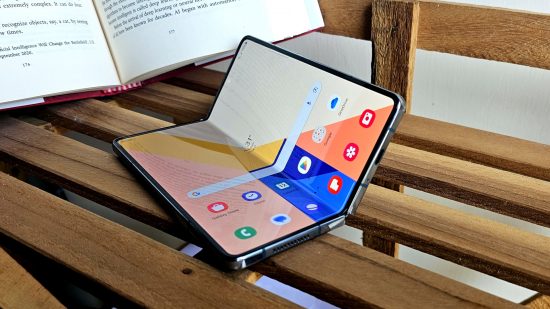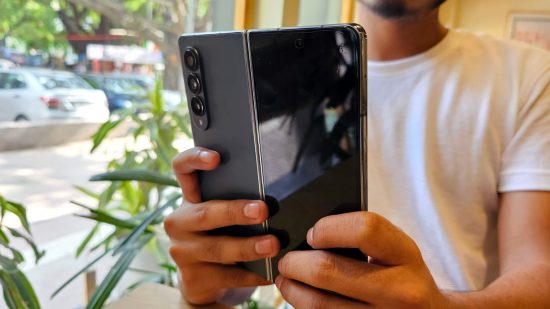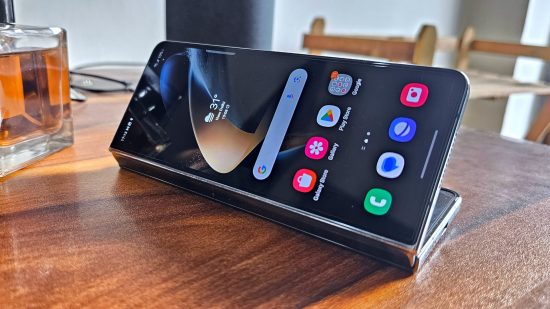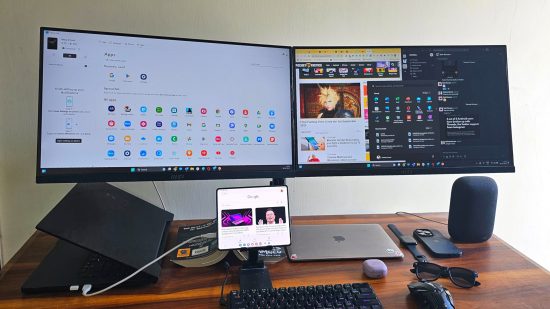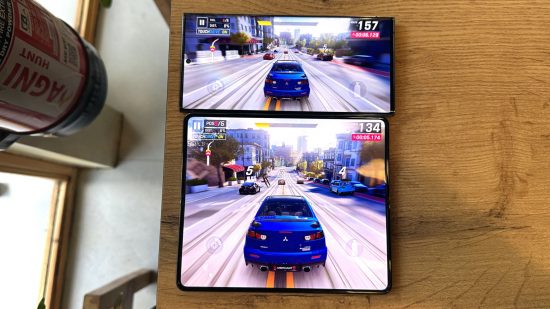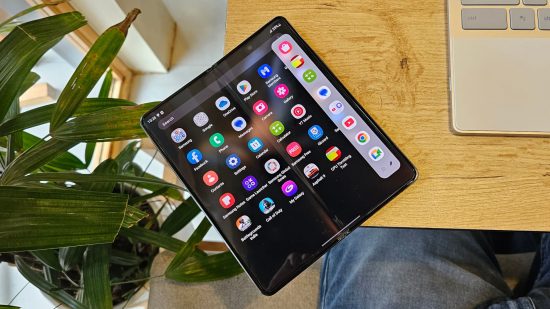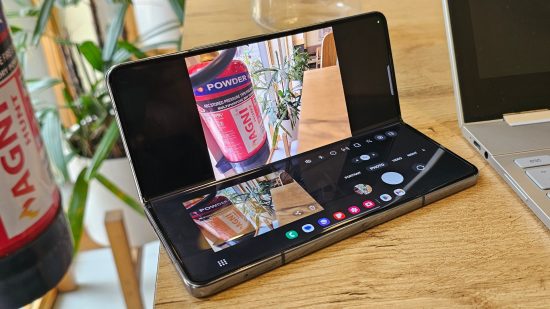Flip phones have come a long way. They’re no longer the chunky bricks with a keyboard and a tiny screen – they’re now fantastic foldable pieces of kit. But do they have grit, or are they all gimmicks? Well, it’s time for us to take an in-depth look at one of the biggest contenders in the foldable world, in our Samsung Galaxy Z Fold4 review.
Of course, whether or not the Galaxy Z Fold4 sizes up as one of the best Samsung phones or the best foldable phones depends on a lot of parameters. So if you’re curious about our process and what features we consider the most important, be sure to check out our how we test breakdown.
Pros:
- Beautiful set of OLED screens
- Feature-loaded software
- Top-notch performance
- Reliable cameras
Cons:
- Unless discounted, the price is too aspirational for the masses
- Camera performance can’t do justice to the hit on wallets
- The odd screen aspect ratio spoils games
- Lack of proper dust and water resistance
Price and availability
The Galaxy Z Fold4 originally carried a sticker price of $1,799 (£1,649) for the base configuration with 256GB onboard storage. But now that the new-and-improved Galaxy Z Fold5 has hit the shelves, you can find the Galaxy Z Fold4 with healthy price cuts and limited-period discounts via major online retailers and offline outlets.
Specs
Galaxy Z Fold4 specs:
| Display | Outer display: 6.2-inch (2316 x 904 pixels) Inner display: 7.6-inch (2176 x 1812 pixels) Dynamic AMOLED 2X 120Hz refresh rate |
| Processor | Qualcomm Snapdragon 8+ Gen 1 |
| RAM | 12GB |
| Storage | 256GB / 512GB / 1TB |
| Cameras | 50-megapixal primary + 12-megapixel ultrawide + 10-megapixel telephoto with 3x optical zoom output, 10-megapixel outer selfie camera, 4-megapixel inner under-display selfie camera |
| Battery | 4,400mAh battery |
| Colors | Beige, burgundy, graygreen, phantom black |
| Dimensions | Folded: 67.1 x 155.1 x 15.8 mm Unfolded: 130.1 x 155.1 x 6.3 mm |
| Weight | 263 grams |
| Software | OneUI 5.1.1 based on Android 13 |
Design
The Galaxy Z Fold4 is not too different from the Galaxy Z Fold3, and it doesn’t stray too far away from its successor, either. The build quality is solid, with Gorilla Glass Victus and metal making the outer shell, while patented UItra-Thin Glass (UTG) protects the inner cover display. It’s as fine as smartphone engineering can get, but not everything is perfect.
There’s a narrow wedge between each half of the phone, which means it’s easy for liquid and particles to make their way inside. Moreover, it’s only IPX8 certified, which means it isn’t tested to survive against dust, but can handle a few splashes or brief immersion in water without frying its circuit board.
You don’t get a microSD card slot, neither is there any space for a headphone jack. The fingerprint sensor is embedded inside the power button on the right edge. It’s fast, reliable, and doesn’t suffer from the woes you often encounter with under-display fingerprint sensors.
Another cool aspect is the inner selfie camera. It’s the under-display type, which means there’s no physical cutout on the display through which the lens peeks. Instead, the camera sensor is positioned beneath a circular segment of the display that adjusts its transparency, allowing light to pass through. During day-to-day tasks, the pixel array in this dot-shaped zone matches with the rest of the screen, and you only notice it if you take a really close look at its mosaic-like appearance.
Overall, the Galaxy Z Fold4 is a beautifully crafted piece of hardware as long as you can ignore the added heft and thickness that comes with it. But it’s also a device sure to attract more attention than you would usually get with any regular phone out there.
Display
Samsung has armed the Galaxy Z Fold4 with a 6.2-inch HD+ OLED panel for the cover display, while on the inside, you get treated to a 7.6-inch QXGA+ foldable screen. Both the panels offer a peak refresh rate of 120Hz. However, depending on the task at hand, the refresh rate can adaptively drop to 1Hz on the inner display to save battery juice, while the cover display can only go down as far as 48Hz.
The inner screen can reach a peak brightness of 1,200 nits, which is enough to render content on the screen under broad daylight with barely any legibility problems. I had no issue handling emails or reading articles on either screen. The colors are vivid, accompanied by satisfactory viewing angles and great contrast.
You can further adjust the display behavior by tweaking its color profile and temperature. I stuck to the default setting and had a great time watching videos and playing games on the inner foldable screen. It’s also quite an experience turning a cutting-edge $1,799 device into a glorified Kindle for reading books.
However, the crease is still very much there, regardless of what angle you look at it. Within a few days I acclimatized to its presence, since my preoccupation was watching content on the inner display and simultaneously running multiple app windows. But it’s hard to get over the fact that the hardware is still fragile and you really need to treat this phone like the proverbial queen.
Yes, if you press hard, your nails leave a slight dent on the inner display, and it doesn’t go away. There’s no pixel damage, but the mark is very much visible. But the fragility is multi-faceted here. I talked to service and repair experts at authorized Samsung outlets across multiple cities, and they told me even a seemingly harmless bump is enough to misalign the hinge parts. And since the hinge assembly is connected to the foldable screen, customers often come with units where damage to one part requires replacing the whole display-hinge kit, which is exorbitantly expensive.
Camera
The Galaxy Z Fold4 sports practically the same camera setup as the Galaxy S23, which costs less than half the price of its foldable sibling. The results, however, are impressive. The Galaxy Z Fold4’s primary 50-megapixel camera takes 12-megapixel pixel-binned photos by default. The pictures turn out sharp with a slightly over-enthusiastic take on saturation, good contrast, and satisfactory dynamic range.
Focus lock is quick and on point, even if you’re close to the subject for taking macro shots. The 12-megapixel ultrawide camera also delivers the signature Samsung color processing with vivid colors, and thankfully, no frustrating edge distortion. However, there’s some noticeable color disparity between pictures taken by the primary and ultrawide sensors.
The 10-megapixel telephoto camera delivers 3x optical zoom range, and it produces well-stabilized shots with plenty of colors, sharp edges, and ample depth. At up to 10x zoom levels, the algorithms do a fine job of compensating for the loss of details with satisfactory color reproduction.
In terms of portrait photography, the primary and telephoto cameras snap crisp shots with good subject separation and a healthy amount of surface details. Edge detection is not nearly as accurate as the iPhone 14 Pro and the blur effect is a bit harsh, but the Galaxy Z Fold4’s portrait shots look more lively courtesy of the higher saturation and contrast.
Night mode is on the same level as iPhones, but it doesn’t quite serve the same kind of magic as the Pixel phones or even the Galaxy S23 Ultra. But as long as there is some amount of light and your hands are steady, cranking up the capture window to max can deliver some beautiful low-light photos.
As far as selfies go, you can either rely on the 10-megapixel front camera on the cover display, or use the rear camera array by enabling the cover preview feature and using the outer display as a viewfinder. The latter is obviously the ideal solution if image quality is your key concern, but on its own, the front camera does a good job.
The skin tone in selfies is slightly warmer than the real color, but details are plenty and textures are preserved well. The inner 4-megapixel under-display camera also captures photos with a vibrant color profile, but they’re not nearly as sharp and details are crushed. Luckily, you can still use it for video calls without the other person noticing any major difference in visual quality. You can check out the pictures above to see the differences in image quality.
When it comes to video capture, the Galaxy Z Fold4 isn’t a lousy shooter by any measure. Just like the photos, videos captured by the foldable phone contain plenty of colors and details with adequate stabilization. If you’re into vlogging, the super steady mode does an impressive job of negating shaky hand movements and delivers smooth video without any discernible loss in quality. You can capture up to 8K 24fps videos with the main camera, but super steady mode limits the video recording quality to 4K 60fps, which isn’t bad at all.
Compared to the iPhone 14 Pro, the Galaxy Z Fold4 lags behind with sub-par stabilization, focus hunting, and overblown highlights. But, on the positive side, there are plenty of camera tricks to play with, such as super slo-mo, director’s view, hyper-lapse video, and more. Overall, the Galaxy Z Fold4 offers a rewarding camera experience, even if it can’t quite catch up with camera-centric beasts like the Galaxy S23 Ultra.
Features
It’s no easy task to sell a $1,800 phone, even if it hides a clever tablet-esque screen inside. Samsung knows that all too well, and has therefore built a few clever tricks that turn the Galaxy Z Fold4 into a legitimate computing powerhouse.
The first perk is DeX, which has been around for a while, but truly comes into its element on a foldable phone or Samsung tablet. Using nothing but a USB type-C cable, I drove an FHD monitor with DeX providing the computing ecosystem. If your workflow ecosystem is locked to Chrome (or any other web browser) and apps that are also available on the Android platform, DeX gets the job done on a large screen.
In my case, I relied predominantly on Chrome with about a dozen tabs in the foreground at any given time, along with Slack, Asana, Trello, Discord, and image editing software like Adobe Photoshop Express or Snapseed. Qualcomm’s Snapdragon 8+ Gen 1 ensured that the experience was smooth, even with three to four app windows active simultaneously.
If you like this side of the Galaxy Z Fold4, there’s more value to be extracted here. In fact, the Galaxy Z Fold4 even surpasses the famed “Apple ecosystem” perks that keep macOS and iOS loyalists from venturing beyond the walled garden of conveniences.
The most notable benefit, in my opinion, is the Phone Link app, which pairs with the ‘link to Windows’ system on a PC. It essentially creates an app-driven virtualized space on your PC where you can experience the entire One UI software on a larger screen. That means you can handle your calls and messages, kill some time on Instagram, or interact with virtually any other app installed on your Galaxy Z Fold4 – except all the mobile action now unfolds on a laptop’s screen or a monitor.
This also somewhat fills the AirDrop-sized gulf for Android and Windows 11-powered machines. For example, you no longer have to deal with Bluetooth, emailing, or Quick Share, as the Phone Link app lets you view the entire gallery on your PC screen and copy whatever media you need. Of course, there are some app scaling limitations, and for good reason. Imagine running Instagram in a 3:2 or 16:9 aspect ratio spanning 27 inches of screen real estate.
It’s somewhat unbelievable to see that the Galaxy Z Fold4 offers that convenience with a wireless approach. Likewise, it also doubles as a secondary screen for your Windows PC. Now, I wouldn’t want to run a full-fledged Windows app on a 7.6-inch screen, but it’s somewhat astonishing to see that, using the pre-loaded Smart View system, you can turn the Samsung foldable phone into a mini monitor.
In my case, I predominantly used the phone’s inner foldable display for non-essential tasks, such as controlling music playback on Spotify or keeping an eye on Twitter. Once again, it’s a wireless perk and a Ctrl + K shortcut is enough to handle the pairing and casting job. Overall, the Galaxy Z Fold4 is the most versatile phone of its kind, and if you can push it for work and play, that sticker price becomes a lot more palatable.
Performance and gaming
The Galaxy Z Fold4 is as good as any other Android flagship out there, thanks to Qualcomm’s Snapdragon 8+ Gen 1 SoC ticking inside. Unless you’re obsessed with benchmark figures, you won’t find the phone stumbling at virtually any task you throw at it. I tried my fair share of Call of Duty: Mobile matches, and lost almost every single round at peak graphics presets.
If you’ve played games on an Android tablet, irrespective of the size, it isn’t the most comfortable experience, as the heft of the device quickly takes a toll on your wrists. The Galaxy Z Fold4 seems to fall in the feather-weight category if you compare it with mainstream tablets owing to its form factor and weight.
But the form factor gives it a unique set of advantages and bestows upon it a few drawbacks, as well. To start, if you intend to play games on the cover display, it’s a tad too narrow, which becomes a problem for games with a ton of on-screen buttons. Plus, in its folded state, the phone is not really forgiving for your fingers and you quickly feel the ache after 15-20 minutes of gaming, dual-handed or otherwise.
Now, the Galaxy Z Fold4 has all the firepower under the hood to ace gaming, and will continue to compete with all top-end mobiles coming in the next few years. But the unique 21.6:18 aspect ratio of the inner foldable display does some weird cropping in games that can ruin the overall experience depending on the game you are playing.
For example, in competitive multiplayer games like Call of Duty: Mobile and Apex Legends, the game scales up vertically, but in doing so, it chops off the gameplay view on either side. Of course, in these types of games, you really need a panorama as wide as possible to keep an eye on enemies lurking on the edges, so the Galaxy Z Fold4 really does hamper your chances.
On the positive side, the larger vertical view makes it easier to spot items or take a shot at opponents. But the advantage here is limited to a handful of games, while the cropping is universal and quite a pain, visually as well as functionally.
Physical shortcomings aside, every game I tested ran at its peak graphics settings by default on the Galaxy Z Fold4. Moreover, it retains its peak performance quite well for extended gaming sessions without abruptly dimming the screen brightness, irrespective of the display you choose to play games on.
Frame rates are consistent, and in games that can go above the 60fps mark, you get a really pleasing visual experience on the inner foldable screen. However, the form factor once again comes to haunt this Samsung offering. There’s only so much space inside a foldable phone’s chassis, and that means despite packing a flagship silicon inside, there isn’t much space left inside to fit something like a decent vapor chamber cooling system.
Take a look at the CPU throttling graph after putting the Galaxy S23 Ultra and the Galaxy Z Fold4 through a synthetic task scenario. On the foldable phone, the CPU reached as low as 66% of its peak capacity to manage the heat, while the Galaxy S23 Ultra dipped much later, and after a brief throttling, started climbing up the performance charts.
As a result, the Galaxy Z Fold4 tends to run hot. The CPU temperature quickly reaches the 50-degrees Celcius mark after playing Genshin Impact for just around 15 minutes. And if you take the phone out for a photography trip it also gets warm, especially while shooting videos. It doesn’t get hot enough that you would want to give it an ice bath, but compared to a regular slab phone, you encounter more frequent heating issues.
On the positive side, the throttling wasn’t abrupt and despite the sustained load, the peak performance only dips gradually, which means it would be nigh impossible to notice during day-to-day tasks. I never bother to clean the background apps, and despite running 2-3 apps simultaneously in windowed mode, I’ve not come across any stutters or instances of unresponsive apps.
Software
Samsung’s One UI Android skin has garnered quite a divisive reputation. Some loathe it for the bloatware and ads, while others swear by the sheer depth of controls that it offers. Now, this might sound controversial, but after having tried foldable phones from Motorola, Oppo, and Tecno, I can confidently say that One UI is miles ahead of any Android skin out there. From a functional perspective, it’s lightyears ahead of what you get with a vanilla Android experience, the likes of which you would find on Google’s Pixel phones.
But let’s broach the hiccups first. The narrow outer display really cramps the UI elements. For example, where you would see three to four tweets at a time on a regular phone’s screen, the Galaxy Z Fold4 has to make adjustments, and as a result, you see fewer posts. The keyboard also feels cramped, and, irrespective of whether you stick with the stock keyboard or a third-party option like Gboard or SwiftKey, typing on it isn’t really a pleasing experience.
But then, you buy the Galaxy Z Fold4 for the productivity potential that unfolds on its inner 7.6-inch screen. I tested the phone running One UI 5.1 based on Android 13, and I intend to focus on the exclusive niceties that Samsung offers on its foldable phone. At the top of my favorites list is the Edge Panel, which hosts your most frequently used apps and a bunch of other productivity tools that you won’t find on many Android phones out there.
An inward swipe from the left or right edge brings it up in the form of a vertical pillar, housing a column of seven apps. You can slide over to show another row of selection tools (shape select, turning screen recording into GIF, etc.), followed by quick tasks (voice recording, alarm controls, screen recording, etc.), clipboard items (both text and multimedia), frequent contacts, weather detail, and reminders.
The entire set is deeply customizable. In fact, it even remembers split-screen app pairs. For example, if you frequently use Gmail and Docs in split-screen mode, the Edge Panel creates an app pair. The next time you open the Galaxy Z Fold4, all you need to do is swipe open the Edge Panel, and your app pair will be ready to launch side-by-side in each half of the screen in the preferred aspect ratio for each app window.
Talking about app windows, One UI 5.1 offers more controls than you would get on any other large-screen device out there, be it Android tablets or the mighty iPad. Each app window is freely resizable. In fact, you can even adjust the transparency of app windows, if that’s a convenience you’ve always fancied in your smartphone daydreams.
If you’re running short of screen real estate, you can turn an app’s window almost transparent. This trick didn’t really win me over, but if you really want a third-party app always in your sight, you can push it into pop-up mode, where its icon always appears on the screen in a minimized format, while tapping on the icon opens it in a floating window.
You can put as many apps in the pop-up view as you want. If there are multiple apps minimized this way, a single tap opens a pill-shaped tray of all those apps for quick selection. For apps that don’t support split-screen mode, there’s the Labs section in the advanced features corner of the settings, where you can manually enable it for any app of your choice.
It’s a neat convenience, actually. Take for example Twitter. If you open the app on the inner display, the UI looks like a stretched mess. When you split it in half, the aspect ratio gets too narrow. However, with a freely resizable window, you can get as close to a regular 9:16 or 19.5:9 aspect ratio as an average slab-shaped smartphone.
Then there’s flex mode, which lets you put the phone in a laptop-like state, while adjusting the UI accordingly. For example, when you open the camera app in flex mode, the viewfinder is pushed to the vertical half of the screen, while the camera controls are on the bottom half lying parallel to the surface it’s placed on.
If you want to go even deeper into the customization rabbit hole, look no further than Samsung Good Lock. The level of customizability that it offers is simply unprecedented in the smartphone ecosystem. You can set up diagonal edge gestures to control the UI, create and customize a keyboard from scratch, enable back-tap gestures, adjust the quick panel’s look to your liking, and even remodel the entire settings app to your own convenience.
Overall, the One UI 5.1 experience is what really lifts the Galaxy Z Fold4 above the rest and turns it into a mobile productivity powerhouse that redefines the boundaries of what a smartphone can accomplish.
Another huge benefit is that the Galaxy Z Fold4 is set to get four annual Android version upgrades and security updates for five years. So, if you can keep your phone in tidy shape, it’ll be good enough to last you half a decade.
Battery life
The 4,400mah dual-cell battery inside the Galaxy Z Fold4 can easily last you a full day. While traveling or on my daily commute, I used it for reading, playing Diablo Immortal for a couple of hours, and taking plenty of photos, and I never ran out of juice, even while tethered to a 5G network at the end of the day. However, if you’re using the phone for video calls and have the inner foldable screen displaying content at 120Hz refresh rate all day, expect some rapid drain.
In the initial phase, the battery consumption is a bit haphazard as the phone learns your usage pattern and accordingly balances the performance, thermals, and battery uptake. But within a week or two, the battery woes should be gone. With an average screen time of around five hours, the Galaxy Z Fold4 consistently makes it past a full day without having to enable the low-power mode or dragging down the refresh rate.
Fast charging is capped at 25W, which is sufficient to juice up half the tank in about 30 minutes, while a full charge takes close to 80 minutes. It’s not the fastest out there, but makes up for it with support for 15W wireless charging and reverse power share. I absolutely love the convenience that I can charge the Galaxy Buds 2 Pro by simply putting it on the phone’s rear panel.
Verdict
The Galaxy Z Fold4 is as good as foldable phones get. And now that it’s a generation older, you can easily get it for a lower asking price without losing much compared to the Galaxy Z Fold5. The only major caveat is the wedge gap when the phone is folded shut. Plus, the lack of proper dust and water resistance is a concern, considering the amount of money you spend on it.
On its own, the Galaxy Z Fold4 delivers a pair of beautiful screens and capable cameras married to feature-rich software and reliable battery life. The form factor is the winner here, but tricks like DeX, Link to Windows, and Smart View turn it into a productivity beast far ahead of the competition. And if you can snag it with a discount deal that’s meaningfully lower than the sticker price, the Galaxy Z Fold4 won’t disappoint you.
Alternatives
The most obvious alternative to the Galaxy Z Fold4 is its successor, which you can learn more about in our Galaxy Z Fold5 review. But if you want to look away from the Samsung ecosystem, your best bet would be the Google Pixel Fold, which offers the renowned Pixel experience in a foldable format for a similar price.
Alternatively, the Honor Magic Vs is a slightly cheaper option that’s packed to the gills with powerful hardware in an extremely slim chassis. Unfortunately, it isn’t officially available in the US, and if you do manage to get your hands on one over in the states, there will be little support for you if anything goes wrong with your device.
But if it’s just the convenience or vanity of the best foldable phones that you seek, you can check out the Oppo Find N2 Flip, Motorola’s Razr 40 Ultra, and Samsung’s own Galaxy Z Flip5 without having to nuke your wallet. Hit the links below to check out each of the individual alternatives.
Galaxy Z Fold5:
Google Pixel Fold:
Honor Magic Vs:
Oppo Find N2 Flip:
Motorola Razr 40 Ultra:
Galaxy Z Flip5:
Well, that’s everything in our Galaxy Z Fold4 review. If you’re planning on picking up this beauty or any other fresh handsets from our best gaming phones, best AT&T phones, or best OnePlus phones guides, you should consider grabbing yourself one of the best phone cases to protect it. And while you’re there, why not get yourself set up with one of the best Mint Mobile plans.
